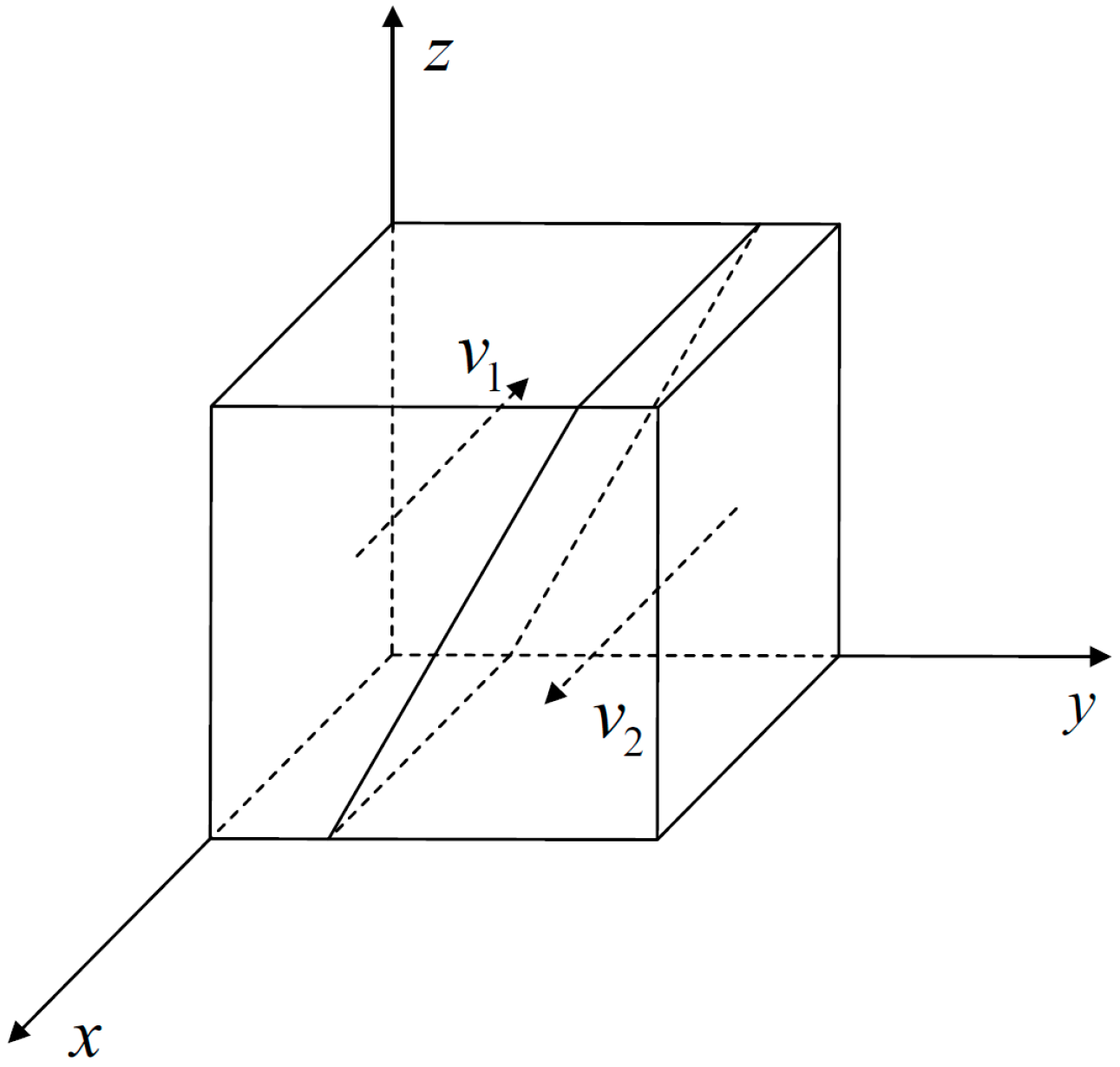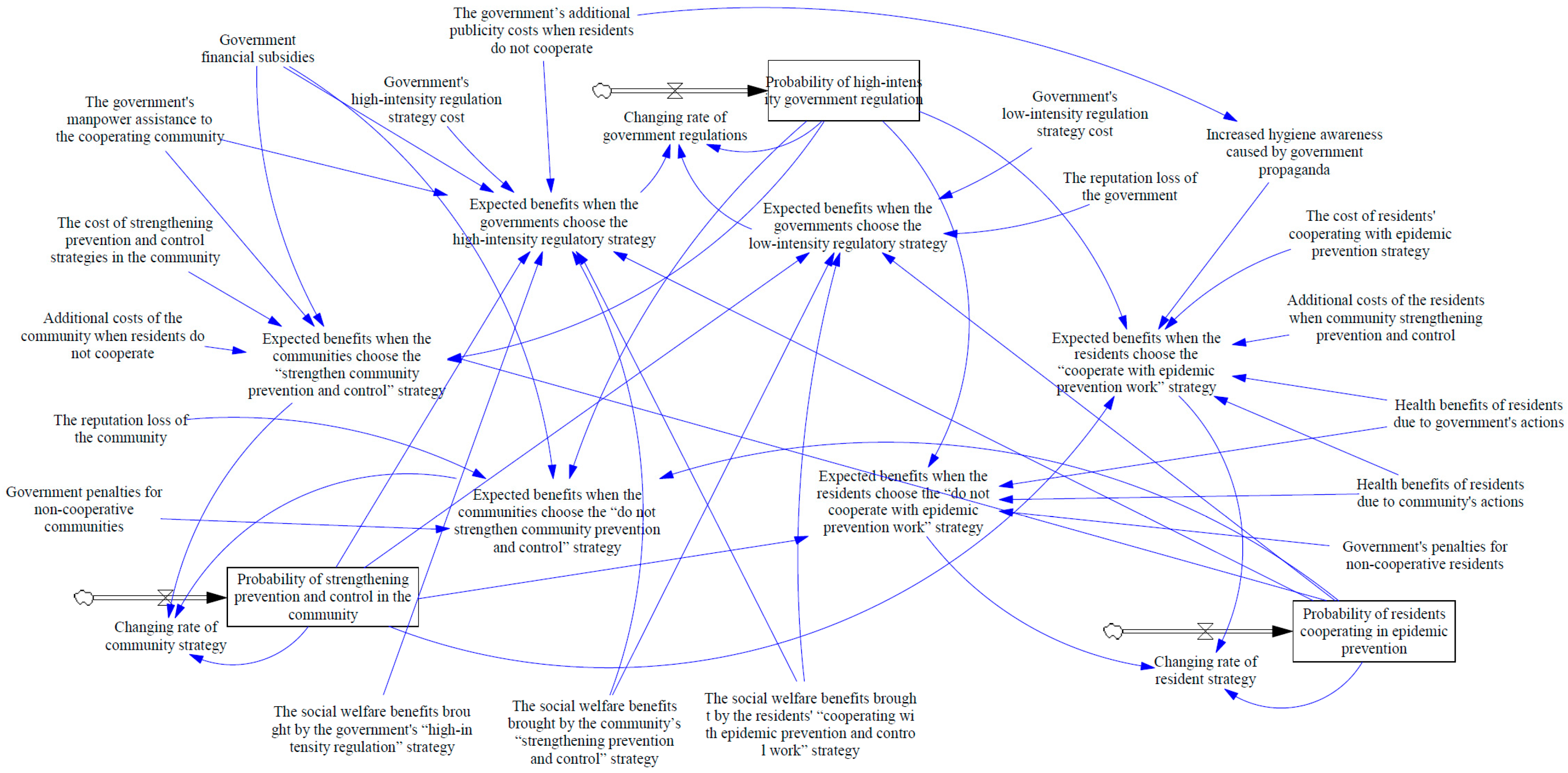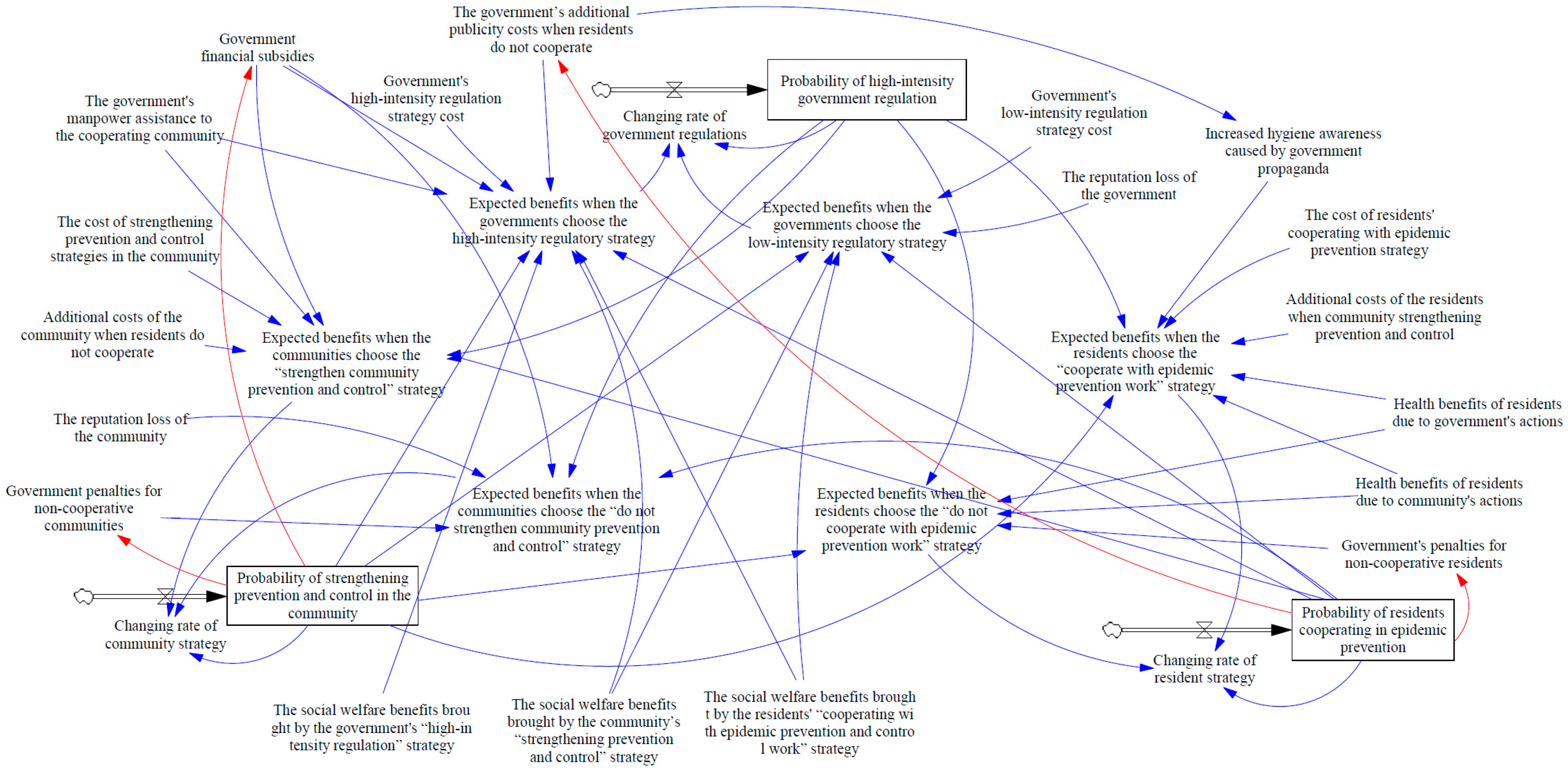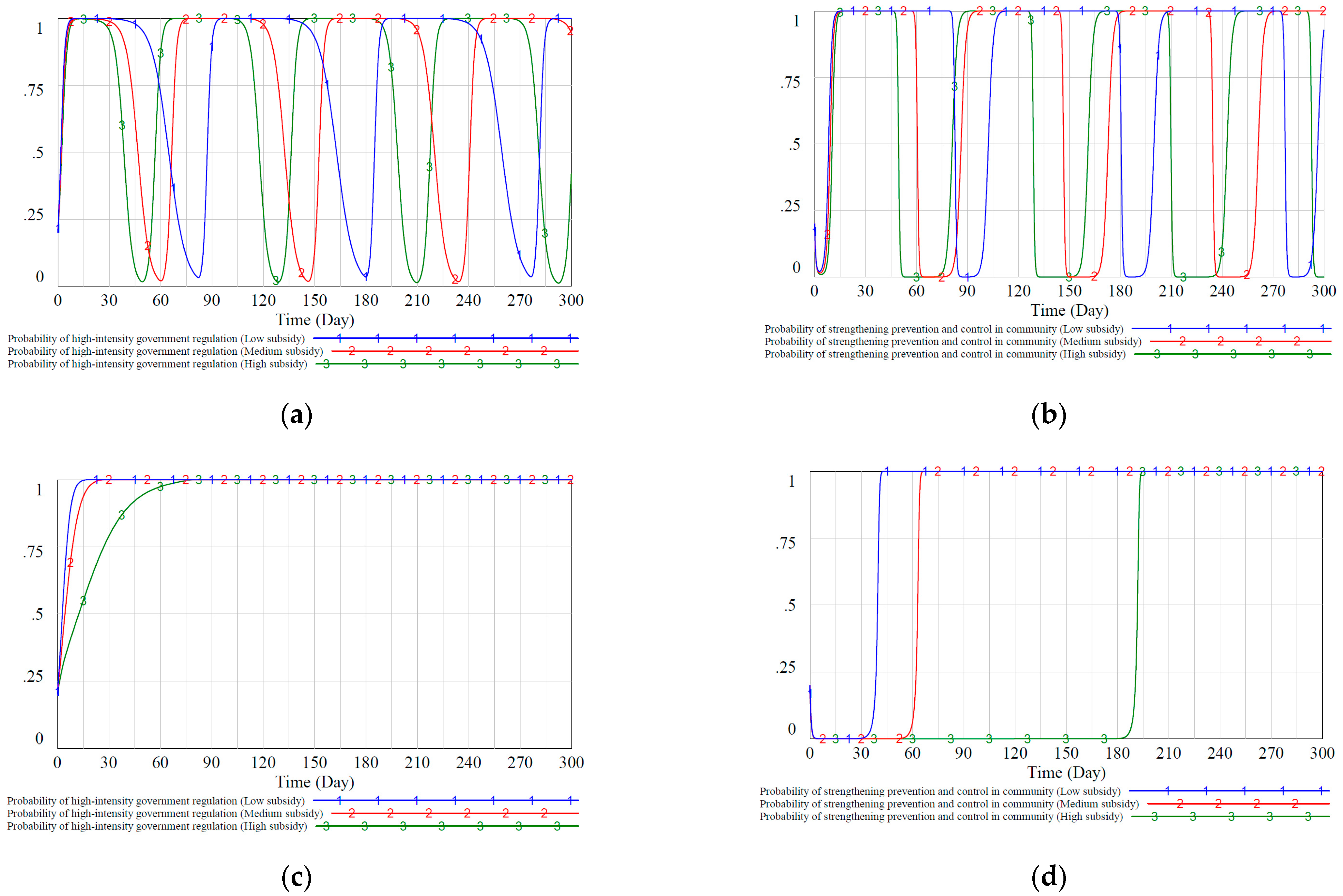Study on Multi-Agent Evolutionary Game of Emergency Management of Public Health Emergencies Based on Dynamic Rewards and Punishments
Abstract
:1. Introduction
2. Literature Review
3. Three-Party Evolutionary Game Modeling and Stability Strategy Analysis
3.1. Parameter Assumptions and Modeling
- Participants of this evolutionary game: The article selects the main relevant interest groups related to prevention and control measures in the epidemic: government, community, and residents. All three types of participants have bounded rationality.
- The government’s game strategy: The government has two strategies under this game model. The first strategy is a high-intensity regulatory strategy. When the government adopts a high-intensity epidemic prevention and control strategy, it brings health benefits to society. At the same time, the government guides communities and residents to strengthen epidemic prevention and control through subsidies, penalties, personnel assistance, and epidemic prevention propaganda. The second strategy is a low-intensity regulatory strategy. The government’s epidemic prevention and control efforts are only maintained at a basic level. No additional prevention and control policies are adopted to mobilize the enthusiasm of communities and residents for prevention and control. Therefore, assuming that the government behavior strategy space is = (: High-intensity prevention and control, : Low-intensity prevention and control), the two strategy probabilities are and , respectively.
- The game strategy of the community: The community has two strategies under this game model. The first strategy is to strengthen prevention and control in the community. The community adopts stronger epidemic prevention and control measures. It provides residents with a safer and healthy environment by blocking the community, restricting travel time, and disinfecting the area under the community’s jurisdiction. The second strategy is not to strengthen community prevention and control. The community does not make additional responses to the epidemic situation, and residents will not receive additional health benefits. Therefore, assuming that the community behavior strategy space is = (: Strengthen community prevention and control, : Do not strengthen community prevention and control), the two strategy probabilities are and , respectively.
- The game strategy of the resident: Residents have two strategies under this game model. The first strategy is to cooperate with epidemic prevention and control work, which means that residents cooperate with the society’s epidemic prevention and control policies, and actively improve their health awareness. The second strategy is not to cooperate with epidemic prevention and control work. Residents do not cooperate with the social epidemic prevention and control policies due to the cost of cooperation or lack of health awareness, making it difficult for the government and the community to carry out epidemic prevention work. Therefore, assuming that the resident’s behavior strategy space is = (: Cooperate with epidemic prevention work, : Do not cooperate with epidemic prevention work), the two strategy probabilities are and , respectively.
- The parameters of the game model: Under each game strategy combination, according to the cost, income, and loss of the government, community, and residents, the parameter settings are shown in Table 1.
- Parameter constraint assumptions: Based on the actual situation of epidemic prevention and control, we make the following assumptions about the parameter constraints in the payment matrix. When the government chooses high-intensity regulation, the cost of the strategy is greater than when it adopts low-intensity regulation, that is . The government’s prevention and control cost should be greater than the prevention and control cost of the community and residents, that is . The prevention and control costs of communities and residents are greater than the government’s punishment for them. Otherwise, the communities and residents will not be motivated to choose negative prevention and control measures, namely , . Similarly, the reputation loss of governments and communities should be less than their prevention and control costs, namely , . The health benefits brought to residents by the government’s active prevention and control should be higher than the health benefits brought to residents by the community’s active prevention and control, namely .
3.2. Analysis of the Evolutionary Stability Strategy of Each Participant
3.2.1. Analysis of the Government’s Evolutionary Stability Strategy
3.2.2. Analysis of the Community’s Evolutionary Stability Strategy
3.2.3. Analysis of the Resident’s Evolutionary Stability Strategy
4. Design and Analysis of Reward and Punishment Mechanism
4.1. System Dynamics Model under the Static Reward and Punishment Mechanism
4.2. System Dynamics Model under Dynamic Reward and Punishment Mechanism
4.3. Simulation Analysis of the Impact of Key Exogenous Variables
4.3.1. The Impact of Government Financial Subsidies to Communities on the Evolutionary Game Process
4.3.2. The Impact of Government Punishment on the Evolutionary Game Process
4.3.3. The Impact of Government Propaganda Measures on the Evolutionary Game Process
5. Conclusions and Policy Implications
Author Contributions
Funding
Institutional Review Board Statement
Informed Consent Statement
Conflicts of Interest
References
- WHO Coronavirus Disease (COVID-19) Dashboard. Available online: https://covid19.who.int/ (accessed on 1 January 2021).
- The Latest Status of the Novel Coronavirus Pneumonia Epidemic. Available online: http://www.nhc.gov.cn/xcs/yqtb/list_gzbd.shtml (accessed on 1 January 2021).
- Notice on Strengthening Community Prevention and Control of Pneumonia Epidemics Caused by New Coronavirus Infection. Available online: http://www.nhc.gov.cn/jkj/s3577/202001/dd1e502534004a8d88b6a10f329a3369.shtml (accessed on 25 January 2020).
- Precise and Refined Guidance Plan for Epidemic Prevention and Control of COVID-19 and Service Work in Community. Available online: http://www.nhc.gov.cn/jws/s7874/202004/8bc0fde9ef6e4820a30b546f396698c0.shtml (accessed on 16 April 2020).
- Guidelines for Prevention and Health Protection against 2019 Novel Coronavirus Pneumonia in Public Places. Available online: http://www.nhc.gov.cn/jkj/s7916/202001/d9ae8301384a4239a8041d6f77da09b6.shtml (accessed on 31 January 2021).
- Bowles, S.; Gintis, H. Social capital and community governance. Econ. J. 2002, 112, F419–F436. [Google Scholar] [CrossRef]
- Parag, Y.; Hamilton, J.; White, V.; Hogan, B. Network approach for local and community governance of energy: The case of Oxfordshire. Energy Policy 2013, 62, 1064–1077. [Google Scholar] [CrossRef]
- Bray, D. Building ‘community’: New strategies of governance in urban China. Econ. Soc. 2006, 35, 530–549. [Google Scholar] [CrossRef]
- Xi, J.P. Secure a decisive victory in building a moderately prosperous society in all respects and strive for the great success of socialism with Chinese characteristics for a new era. In Proceedings of the 19th National Congress of the Communist Party of China, Beijing, China, 18–24 October 2017. [Google Scholar]
- Li, K.Q. Report on the Work of the Government. In Proceedings of the Second Session of the 13th National People’s Congress of the People’s Republic of China, Beijing, China, 8–20 March 2019. [Google Scholar]
- Marston, C.; Renedo, A.; Miles, S. Community participation is crucial in a pandemic. Lancet 2020, 395, 1676–1678. [Google Scholar] [CrossRef]
- Blendon, R.J.; Koonin, L.M.; Benson, J.M.; Cetron, M.S.; Pollard, W.E.; Mitchell, E.W.; Weldon, K.J.; Herrmann, M.J. Public response to community mitigation measures for pandemic influenza. Emerg. Infect. Dis. 2008, 14, 778. [Google Scholar] [CrossRef] [PubMed]
- Byambasuren, O.; Cardona, M.; Bell, K.; Clark, J.; McLaws, M.L.; Glasziou, P. Estimating the extent of asymptomatic COVID-19 and its potential for community transmission: Systematic review and meta-analysis. Off. J. Assoc. Med. Microbiol. Infect. Dis. Can. 2020, 5, 223–234. [Google Scholar]
- Liu, J.; Liao, X.; Qian, S.; Yuan, J.; Wang, F.; Liu, Y.; Wang, Z.; Wang, F.S.; Liu, L.; Zhang, Z. Community transmission of severe acute respiratory syndrome coronavirus 2, Shenzhen, China, 2020. Emerg. Infect. Dis. 2020, 26, 1320. [Google Scholar] [CrossRef] [PubMed]
- Longini, I.M., Jr.; Koopman, J.S.; Monto, A.S.; Fox, J.P. Estimating household and community transmission parameters for influenza. Am. J. Epidemiol. 1982, 115, 736–751. [Google Scholar] [CrossRef] [PubMed]
- Eikenberry, S.E.; Mancuso, M.; Iboi, E.; Phan, T.; Eikenberry, K.; Kuang, Y.; Kostelich, E.; Gumel, A.B. To mask or not to mask: Modeling the potential for face mask use by the general public to curtail the COVID-19 pandemic. Infect. Dis. Model. 2020, 5, 293–308. [Google Scholar] [CrossRef]
- Fischer, E.P.; Fischer, M.C.; Grass, D.; Henrion, I.; Warren, W.S.; Westman, E. Low-cost measurement of face mask efficacy for filtering expelled droplets during speech. Sci. Adv. 2020, 6, eabd3083. [Google Scholar] [CrossRef]
- Li, T.; Liu, Y.; Li, M.; Qian, X.; Dai, S.Y. Mask or no mask for COVID-19: A public health and market study. PLoS ONE 2020, 15, e0237691. [Google Scholar] [CrossRef]
- Andersen, M. Early Evidence on Social Distancing in Response to COVID-19 in the United States. Available online: https://ssrn.com/abstract=3569368 (accessed on 30 June 2020).
- Lewnard, J.A.; Lo, N.C. Scientific and ethical basis for social-distancing interventions against COVID-19. Lancet Infect. Dis. 2020, 20, 631–633. [Google Scholar] [CrossRef] [Green Version]
- Qian, M.; Jiang, J. COVID-19 and social distancing. J. Public Health 2020, 1–3. [Google Scholar] [CrossRef]
- Chinazzi, M.; Davis, J.T.; Ajelli, M.; Gioannini, C.; Litvinova, M.; Merler, S.; Piontti, A.P.Y.; Mu, K.; Rossi, L.; Sun, K. The effect of travel restrictions on the spread of the 2019 novel coronavirus (COVID-19) outbreak. Science 2020, 368, 395–400. [Google Scholar] [CrossRef] [Green Version]
- Linka, K.; Peirlinck, M.; Sahli Costabal, F.; Kuhl, E. Outbreak dynamics of COVID-19 in Europe and the effect of travel restrictions. Comput. Methods Biomech. Biomed. Eng. 2020, 23, 710–717. [Google Scholar] [CrossRef]
- Zhu, C.; Fan, R.; Luo, M.; Lin, J.; Zhang, Y. Urban food waste management with multi-agent participation: A combination of evolutionary game and system dynamics approach. J. Clean. Prod. 2020, 275, 123937. [Google Scholar] [CrossRef]
- Luo, M.; Fan, R.; Zhang, Y.; Zhu, C. Environmental governance cooperative behavior among enterprises with reputation effect based on complex networks evolutionary game model. Int. J. Environ. Res. Public Health 2020, 17, 1535. [Google Scholar] [CrossRef] [PubMed] [Green Version]
- Zhang, H.; Xu, Z.; Zhou, D.; Cao, J. Waste cooking oil-to-energy under incomplete information: Identifying policy options through an evolutionary game. Appl. Energy 2017, 185, 547–555. [Google Scholar] [CrossRef]
- Zhang, H.F.; Wu, Z.X.; Tang, M.; Lai, Y.C. Effects of behavioral response and vaccination policy on epidemic spreading-an approach based on evolutionary-game dynamics. Sci. Rep. 2014, 4, 1–10. [Google Scholar] [CrossRef] [PubMed] [Green Version]
- Li, Q.; Li, M.; Lv, L.; Guo, C.; Lu, K. A new prediction model of infectious diseases with vaccination strategies based on evolutionary game theory. Chaos Solitons Fractals 2017, 104, 51–60. [Google Scholar] [CrossRef]
- Yong, J.C.; Choy, B.K. Noncompliance with Safety Guidelines as a Free-Riding Strategy: An Evolutionary Game-Theoretic Approach to Cooperation During the COVID-19 Pandemic. Front. Psychol. 2021, 12, 646892. [Google Scholar] [CrossRef] [PubMed]
- Zhu, C.; Fan, R.; Lin, J. The impact of renewable portfolio standard on retail electricity market: A system dynamics model of tripartite evolutionary game. Energy Policy 2020, 136, 111072. [Google Scholar] [CrossRef]
- Wu, B.; Liu, P.; Xu, X. An evolutionary analysis of low-carbon strategies based on the government–enterprise game in the complex network context. J. Clean. Prod. 2017, 141, 168–179. [Google Scholar] [CrossRef]
- Yi, Z.; Xin-gang, Z.; Yu-zhuo, Z.; Ying, Z. From feed-in tariff to renewable portfolio standards: An evolutionary game theory perspective. J. Clean. Prod. 2019, 213, 1274–1289. [Google Scholar] [CrossRef]
- Liu, Q.; Li, X.; Meng, X. Effectiveness research on the multi-player evolutionary game of coal-mine safety regulation in China based on system dynamics. Saf. Sci. 2019, 111, 224–233. [Google Scholar] [CrossRef]
- Tian, Y.; Govindan, K.; Zhu, Q. A system dynamics model based on evolutionary game theory for green supply chain management diffusion among Chinese manufacturers. J. Clean. Prod. 2014, 80, 96–105. [Google Scholar] [CrossRef]
- Kelly, F.P.; Maulloo, A.K.; Tan, D.K. Rate control for communication networks: Shadow prices, proportional fairness and stability. J. Oper. Res. Soc. 1998, 49, 237–252. [Google Scholar] [CrossRef]
- Zhou, X.; Zhao, R.; Cheng, L.; Min, X. Impact of policy incentives on electric vehicles development: A system dynamics-based evolutionary game theoretical analysis. Clean Technol. Environ. Policy 2019, 21, 1039–1053. [Google Scholar] [CrossRef]









| Parameter | Definition |
|---|---|
| Government’s low-intensity regulation strategy cost | |
| Government’s high-intensity regulation strategy cost | |
| The cost of strengthening prevention and control strategies in the community | |
| The cost of residents’ cooperating with epidemic prevention strategy | |
| The social welfare benefits brought by the government’s “high-intensity regulation” strategy | |
| The social welfare benefits brought by the community’s “strengthening prevention and control” strategy | |
| The social welfare benefits brought by the residents’ “cooperating with epidemic prevention and control work” strategy | |
| The government’s manpower assistance to the cooperating community | |
| The reputation loss of the government not adopting high-strength regulatory measures during the epidemic | |
| The reputation loss of the community not strengthening community prevention and control during the epidemic | |
| The government’s additional publicity costs when residents do not cooperate | |
| Government financial subsidies to communities | |
| Government penalties for non-cooperative communities | |
| Government’s penalties for non-cooperative residents | |
| Additional costs of the community when residents do not cooperate | |
| Additional costs of the residents when community strengthening prevention and control | |
| Residents’ acceptance to propaganda measures | |
| Increased hygiene awareness caused by government propaganda, | |
| Health benefits of residents due to government’s actions | |
| Health benefits of residents due to community’s actions |
| Government Strategy: | ||
| Resident strategy: | Resident strategy: | |
| community strategy: | ||
| community strategy: | ||
| Government Strategy: | ||
| Resident strategy: | Resident strategy: | |
| community strategy: | ||
| community strategy: | 0 | |
| Feasible Regions | ||||
Publisher’s Note: MDPI stays neutral with regard to jurisdictional claims in published maps and institutional affiliations. |
© 2021 by the authors. Licensee MDPI, Basel, Switzerland. This article is an open access article distributed under the terms and conditions of the Creative Commons Attribution (CC BY) license (https://creativecommons.org/licenses/by/4.0/).
Share and Cite
Fan, R.; Wang, Y.; Lin, J. Study on Multi-Agent Evolutionary Game of Emergency Management of Public Health Emergencies Based on Dynamic Rewards and Punishments. Int. J. Environ. Res. Public Health 2021, 18, 8278. https://doi.org/10.3390/ijerph18168278
Fan R, Wang Y, Lin J. Study on Multi-Agent Evolutionary Game of Emergency Management of Public Health Emergencies Based on Dynamic Rewards and Punishments. International Journal of Environmental Research and Public Health. 2021; 18(16):8278. https://doi.org/10.3390/ijerph18168278
Chicago/Turabian StyleFan, Ruguo, Yibo Wang, and Jinchai Lin. 2021. "Study on Multi-Agent Evolutionary Game of Emergency Management of Public Health Emergencies Based on Dynamic Rewards and Punishments" International Journal of Environmental Research and Public Health 18, no. 16: 8278. https://doi.org/10.3390/ijerph18168278
APA StyleFan, R., Wang, Y., & Lin, J. (2021). Study on Multi-Agent Evolutionary Game of Emergency Management of Public Health Emergencies Based on Dynamic Rewards and Punishments. International Journal of Environmental Research and Public Health, 18(16), 8278. https://doi.org/10.3390/ijerph18168278






